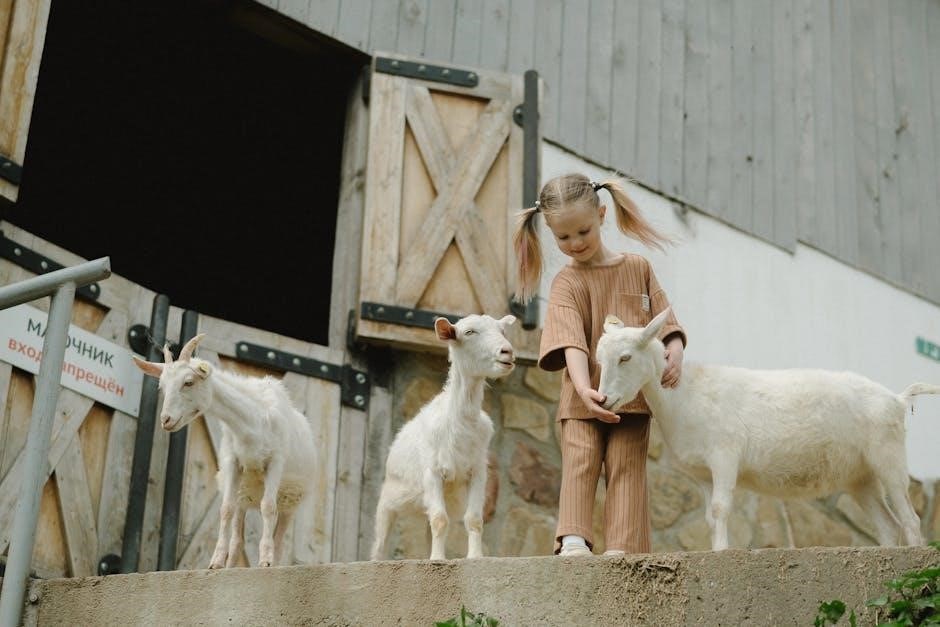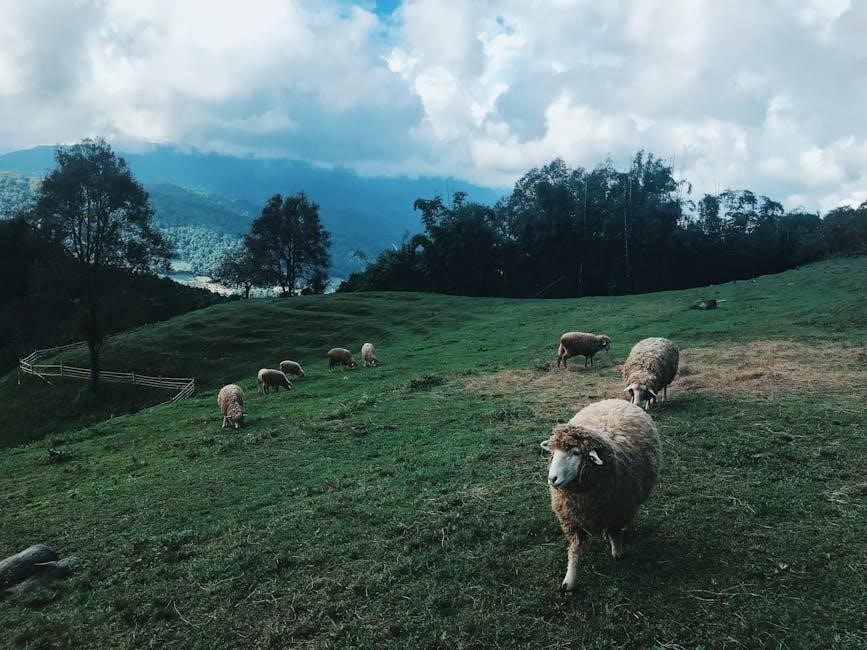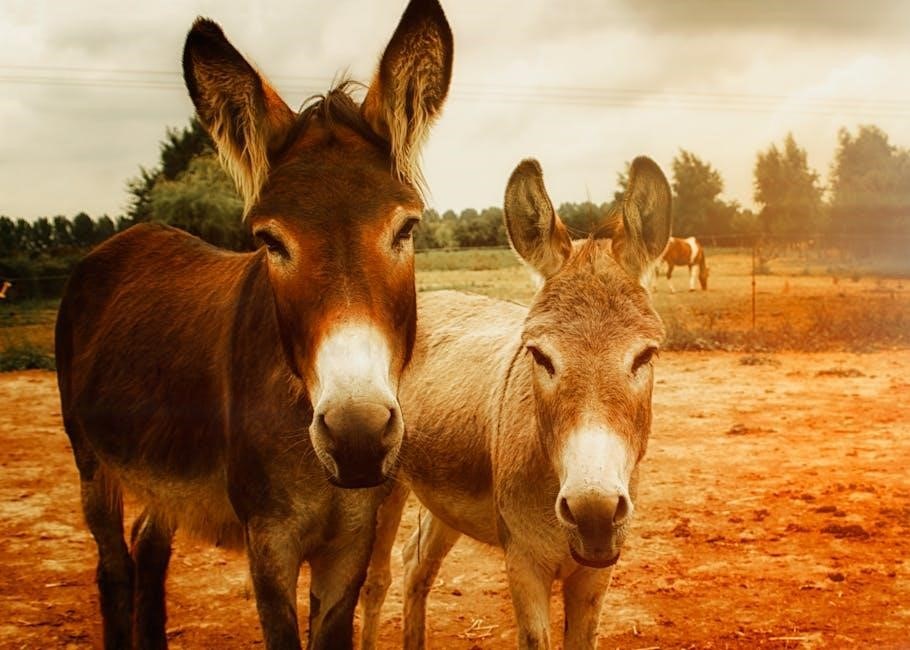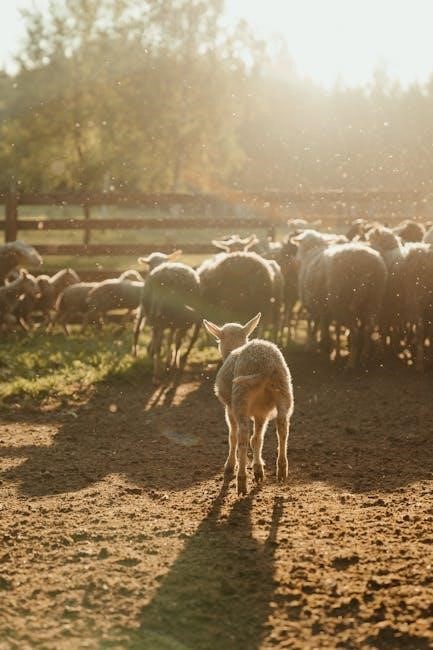This engaging lesson plan introduces students to farm animals, exploring their basic needs, habitats, and roles. Designed for K-3, it fosters curiosity and foundational learning through interactive activities.
Overview of the Lesson Plan Structure
This lesson plan is tailored for K-3 students, offering a comprehensive yet flexible structure to explore farm animals. It integrates math, literacy, STEM, science, and phonics, ensuring a well-rounded learning experience. The plan includes engaging activities such as crafts, games, and role-playing to captivate young learners. Each session is supported by downloadable PDF materials, providing teachers with ready-to-use resources. The structure emphasizes hands-on learning, fostering curiosity and understanding of farm animals’ roles and needs. Additional resources, like recommended websites and books, enhance the educational experience. This organized approach ensures a balanced blend of fun and education, making it easy for educators to implement and adapt to their classroom needs.
Learning Objectives for Students
By the end of this lesson, students will be able to identify and name common farm animals, understand their basic needs, and recognize their roles on a farm. Students will also develop essential skills through interactive activities, such as matching games and role-playing, to enhance their understanding of farm life. The lesson aims to foster curiosity, creativity, and critical thinking while introducing foundational concepts in math, literacy, and science. Students will engage in hands-on projects, such as crafting animal models, to reinforce learning. Additionally, they will participate in discussions about animal care and habitats, promoting empathy and responsibility. These objectives ensure a holistic learning experience tailored to young learners’ developmental needs.
Understanding Farm Animal Basics
Introduce students to common farm animals, their sounds, and roles. Explore their habitats and basic care needs, fostering an early understanding of farm life and animal diversity.
Identifying Common Farm Animals
Introduce students to common farm animals such as cows, pigs, chickens, and sheep. Use pictures, flashcards, or real-life examples to help them recognize and name each animal. Discuss their unique sounds and roles on the farm, such as providing milk, eggs, or wool. This activity helps students build vocabulary and connect animals to their purposes. Encourage students to share what they know or have observed about these animals. Interactive discussions and visual aids make learning engaging and fun for young learners, laying the foundation for understanding farm life and ecosystems.
Basic Needs of Farm Animals
Farm animals require essential care to thrive, including food, water, shelter, and proper healthcare. Teach students about the specific needs of different animals, such as cows needing grass or hay, chickens requiring feed, and pigs needing space to move. Emphasize the importance of clean water and protective shelters from weather and predators. Discuss how farmers ensure these needs are met, such as providing nutritious diets and regular veterinary check-ups. Engage students by comparing these needs to their own, fostering empathy and understanding of responsible animal care. Hands-on activities, like creating feeding charts or designing shelters, can reinforce these concepts and promote active learning.

Engaging Activities for Students
Crafts, interactive games, and role-playing encourage hands-on learning about farm animals. STEM projects and creative art foster curiosity and teamwork, making lessons memorable and enjoyable for all ages.
Farm Animal Crafts and Art Projects
Farm animal crafts and art projects are a great way to engage students creatively. Activities include making animal masks, painting farm scenes, or creating 3D models. These hands-on tasks allow students to express their imagination while learning about different farm animals. Printable templates and step-by-step guides are often provided in lesson plans to simplify the process. Crafting encourages fine motor skills and teamwork, making it an ideal activity for young learners. Art projects also help students visualize and remember the characteristics of farm animals, reinforcing their understanding of the topic. Many resources offer free downloadable materials, such as coloring sheets or DIY kits, to support these activities. This creative approach makes learning about farm animals both fun and educational for students of all ages.
Interactive Games and Role-Playing

Interactive games and role-playing activities bring farm animals to life for students. Games like “Pin the Tail on the Cow” or “Old MacDonald Had a Farm” animal sounds matching encourage participation and laughter. Role-playing scenarios, such as running a pretend farm or acting as veterinarians, help students understand animal care and responsibilities. These activities promote teamwork, problem-solving, and creativity while reinforcing learning. Many lesson plans include downloadable game templates or instructions for setting up farm-themed play areas. Such engaging methods make learning about farm animals enjoyable and immersive, ensuring students retain the information while developing essential social skills. These interactive elements are a highlight of the lesson plan, making it dynamic and student-centered.
STEM Activities Related to Farm Animals
STEM activities in the farm animals lesson plan encourage hands-on learning and creativity. Students can design and build model animal shelters using everyday materials, exploring concepts of structure and stability. Another activity involves creating a farm ecosystem diorama, where students learn about habitats and environmental balance. Additionally, a “Feed the Animals” math challenge teaches measurement and ratios by calculating food portions for different animals. These activities integrate engineering, biology, and problem-solving skills, fostering a deeper understanding of farm animal care and management. Many lesson plans include templates and instructions for these STEM projects, ensuring a fun and educational experience for students. These exercises not only enhance critical thinking but also promote an appreciation for the role of STEM in agriculture and animal husbandry.

Integration with Other Subjects
Farm animals lesson plans seamlessly connect with math, literacy, STEM, and science, fostering a comprehensive learning experience. Activities promote cross-curricular skills and creative thinking in engaging ways.
Math and Literacy Activities
Math and literacy activities in the farm animals lesson plan encourage students to count animals, solve basic arithmetic problems, and practice reading comprehension. For example, students can count the number of cows in a picture and solve simple addition or subtraction problems using farm animal themes. Literacy activities include reading stories about farm animals and identifying vocabulary related to farms. These activities are designed to be engaging and educational, helping students develop essential skills while learning about farm animals. The integration of math and literacy with farm themes makes learning fun and relevant for young students.
Science and Phonics Connections
Science and phonics connections in the farm animals lesson plan help students explore the natural world while developing language skills. Science activities include observing animal life cycles, understanding habitats, and conducting simple experiments, such as growing plants that animals eat. Phonics lessons incorporate farm-themed words, teaching students to recognize sounds and build vocabulary. For example, students can match animal pictures with their names, enhancing phonemic awareness. These activities integrate seamlessly, allowing students to learn scientifically and linguistically. By linking science and phonics, the lesson plan creates a holistic learning experience that fosters curiosity and language development through engaging farm animal content.

Assessment and Evaluation
Assessment involves evaluating student participation, completed worksheets, and knowledge retention through quizzes. Progress is measured against learning objectives, ensuring understanding of farm animal concepts and skills.
Student Participation and Engagement
Student participation is crucial for effective learning. Encourage active involvement through role-playing, group discussions, and hands-on activities. Monitor engagement levels to ensure all students contribute meaningfully. Provide positive feedback to motivate and build confidence. Create a supportive environment where students feel comfortable sharing ideas. Use interactive tools like flashcards or games to maintain interest. Track participation through observation checklists and informal assessments. Adjust activities to cater to different learning styles, ensuring inclusivity. Recognize and reward enthusiastic contributors to foster a positive classroom atmosphere. This approach helps in assessing their understanding and promoting collaborative learning experiences.
Assessment Tools and Worksheets
Evaluate student understanding using tailored assessment tools and worksheets. Downloadable PDF resources include quizzes, activity sheets, and matching games aligned with lesson objectives. These tools help gauge knowledge retention and skill development. Worksheets focus on identification, labeling, and short-answer questions about farm animals. Quizzes assess comprehension of basic needs and habitats. Activity sheets reinforce learning through puzzles and drawing tasks. Teachers can track progress and identify areas needing review. These resources are designed to be engaging and educational, ensuring a comprehensive understanding of farm animals. They are easily accessible and printable, making them ideal for classroom use. Regular assessments help monitor student growth and engagement throughout the lesson plan.
Additional Resources
Discover free downloadable PDF materials, recommended websites, and engaging books to enhance your farm animals lesson plan. These resources offer comprehensive support for educators and students alike.
Free Downloadable PDF Materials
Enhance your lesson plan with free downloadable PDF materials, including activity sheets, teacher guides, and student worksheets. These resources provide comprehensive lesson structures, engaging activities, and educational content. PDF files offer detailed instructions for crafts, games, and STEM projects, ensuring a well-rounded learning experience. Designed for various age groups, these materials cater to different learning needs and styles. From identifying farm animals to understanding their basic needs, these downloadable resources make lesson planning efficient and enjoyable. They also include assessment tools and creative exercises to track student progress and encourage participation. Perfect for educators seeking structured yet flexible teaching aids, these PDF materials are a valuable addition to any farm animals lesson plan.
Recommended Websites and Books
For a comprehensive learning experience, explore recommended websites like ESL KidStuff and educational platforms offering interactive farm animal content. Books such as “Old MacDonald’s Farm” and “The Big Red Barn” provide engaging stories and visuals. These resources complement the lesson plan by offering additional insights into farm animal behavior, sounds, and roles. Websites often include downloadable worksheets and activity ideas, while books serve as storytelling tools to captivate young learners. Combining these materials enriches the curriculum, making it both educational and enjoyable for students. They align perfectly with the lesson plan’s objectives, providing a well-rounded exploration of farm animals and their significance.